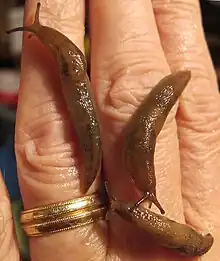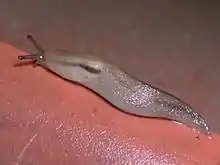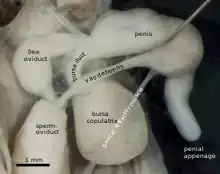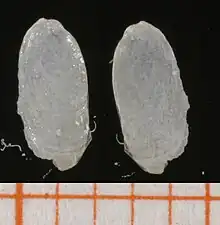| Ambigolimax valentianus | |
|---|---|
 | |
| Scientific classification | |
| Domain: | Eukaryota |
| Kingdom: | Animalia |
| Phylum: | Mollusca |
| Class: | Gastropoda |
| Subclass: | Heterobranchia |
| Order: | Stylommatophora |
| Superfamily: | Limacoidea |
| Family: | Limacidae |
| Genus: | Ambigolimax |
| Species: | A. valentianus |
| Binomial name | |
| Ambigolimax valentianus | |
| Synonyms | |
|
Limax valentianus, Lehmannia valentiana, Limax poireri Mabille, 1883,[4] Lehmannia getica Grossu, 1970[5] | |
Ambigolimax valentianus (also known as Lehmannia valentiana) is a species of terrestrial slug, a pulmonate gastropod mollusc in the family Limacidae. It has spread very widely around the world, especially in greenhouses, where it can be a pest; in warmer climates it has often then spread outdoors. Comparatively much has been learnt about its life cycle and temperature relations. Dissection is necessary to reliably distinguish it from congeners in regions where these co-occur.
Description


External appearance does not reliably distinguish Ambigolimax valentianus from other members of the genus, such as A. parvipenis, with which it may co-occur. Like other members of the Limacidae, it has a pointed tail and the pneumostome lies in the posterior half of the mantle. Often the most obvious character of an Ambigolimax slug is the two parallel, sharply defined, dark lines along the mantle, sometimes with a thicker less well defined line lying between. Two similar lines may lie more posteriorly along the back either side of the midline, but all these lines may be faint or even absent in some individuals. Others have further dots and mottled patches of darker pigment. The dorsal coloration is most often pinkish brown, but sometimes dull yellowish or grey, and all shades inbetween. Older individuals tend to be yellower with less prominent lines but more prominent mottling.[6] The mucus is colourless, transparent, and watery. Maximum length is about 8 cm.[7][3]
Ambigolimax valentianus is identifiable from the internal genitalia, which require dissection to examine. In particular it has a substantial sausage-shaped penial appendage at the inner end of the penis; rarely the appendage is swollen towards its tip.[8] Sometimes the appendage appears absent because it is inverted into the lumen of the penis.[7] This might cause confusion with A. parvipenis but the penis of A. valentianus without the appendage is about as long as the bursa copulatrix and its duct, whereas it is only about half the length in A. parvipenis.[9]
Life cycle and ecology
In captivity, at about 17 °C, eggs took roughly 3 weeks to hatch, and hatchlings took about 24 weeks to first lay eggs. These slugs laid of the order of 150 eggs in their lifetimes, but one individual laid 1510 eggs. Eggs were laid in clutches, ranging widely in size but 40 eggs was typical. About half of slugs kept singly had died within 15 months, but some lived for over two years.[10] At 5 °C eggs took much longer to hatch (17 weeks); above 25 °C all eggs died, although a small proportion survived briefer (1 hour) exposures to 31 °C. Hatchlings mostly survived 34 °C, but not 36 °C.[11] However, resistance to heat varies adaptively through the year, as does resistance to cold; in the middle of winter half the individuals could survive −8 °C, whereas for hatchlings in March the equivalent figure was −3 °C.[12]
In subtropical parts of Japan, A. valentianus has an annual life cycle and reproduces during the colder part of the year; egg laying occurs between November and May but is depressed in the coldest months. Sperm is first produced a little earlier during development than eggs. Most eggs hatch in April. In spring two generations of the slug coexist, overlapping in size, before the older generation dies off by June.[6][11] In more temperate parts of Japan, the life cycle is similar, but shifted two months earlier, so that slugs mature already by August or September and die by May. In both populations the trigger for maturation is day length.[13]
Slugs kept singly without the opportunity to mate nevertheless produced as many fertile eggs as those kept in groups.[10] However, population genetic data implies that free-living individuals largely cross with others.[14]
Ambigolimax valentianus eats green leaves and shoots,[6] and consequently can be a pest in greenhouses[15] or even outdoors.[16] It also eats animal matter and fallen leaves.[11] Activity and feeding start before sunset, peaking in the earlier part of the night.[17] This species seldom climbs up trees and during the day is most commonly found under boards, rocks and plant containers.[18][7] Often its first discovery in a country has been in greenhouses, from whence it has spread to gardens, other synanthropic habitats outdoors, and even to woodland, likely facilitated nowadays by global warming.[19][20][7][21] Where it has been introduced, this species may become the dominant slug.[22][18][23] A bizarre consequence of its abundance on Gough Island is that it prevented the eradication of another introduction, the house mouse, by consuming the poison bait dropped from helicopters.[24]
Distribution
This species has been recorded widely around the world, with its spread starting over 100 years ago.[8] In the following list, oceanic islands are considered separately from the mainland countries to which they belong. If the date of first collection is not given in the cited source, the publication date of the first report is listed instead.

Europe
- Spain: since 1821[2]
- Portugal: since 1891[8]
- Andorra: since 2000[25]
- France: since 1954[8]
- Great Britain: since 1936 (greenhouses),[8] 1985–1986 (outdoors)[26]
- Island of Ireland: since 1932 (botanic garden),[9] 1981 (outdoors)[26]
- Belgium: since 1946 (greenhouse), 1973 (outdoors)[27]
- The Netherlands: since 1962[28]
- Germany: since 1948 (greenhouse)[29]
- Denmark: since 1959[8]
- Sweden: since 1921 (greenhouses)[8]
- Norway: since 1967 (greenhouses)[30]
- Finland: since 1960s (greenhouses)[31]
- Latvia: since 2009 (botanical garden)[32]
- Lithuania: since 2010 (indoor garden)[15]
- Poland: since 1963[33]
- Switzerland: isolated report from 1918[34]
- Italy: since 1979 (outdoors)[35]
- Malta: since 1986[36]
- Czech Republic: since 1960 (greenhouses)[37]
- Slovakia: since 2020 (outdoors)[38]
- Austria: since 1980 (botanical garden)[39]
- Serbia: since 2010 (indoor garden)[19]
- Greece: since 2007[40]
- Romania: since 1962 (greenhouses)[41]
- European Russia: since 1980[42]
Africa
- Algeria: since 19th century[9]
- Morocco: since 1985[43]
- Libya: since 2018–2019[44]
- Egypt: since 2014–2018[45]
- South Africa: since 1961[8]
Asia
- Turkey: since 2017[46]
- Israel: since 1979,[47] by 2015 the commonest garden slug[48]
- Uzbekistan: since 1980[42]
- Kazakhstan: since 1996[49]
- Iran: since 2004:[50]
- Japan: since late 1950s[13]
- China: since 1978[51]
- Singapore: since 2020 (in cooled glasshouses)[52]
Australasia
Americas
- USA: since 1917 (greenhouses); already by 1961 known from California, Colorado, Missouri, Arizona, Oklahoma, New York State, Michigan, Ohio, New Jersey, Massachusetts, Pennsylvania, Kansas, Maryland[8]
- Canada: since 1972 (greenhouses, Manitoba), 2000 (outdoors, British Columbia)[54]
- Dominican Republic: since 2012[55]
- Mexico: since 2017[56]
- Colombia: since 1963[8]
- Venezuela: since 1982[57]
- Brazil: since 1976[58]
- Argentina: since 1924[59]
- Chile: since 1893[8]
Oceanic Islands
- Canary Islands (Spain): since 1950[8]
- Azores (Portugal): since 1957[8]
- Madeira (Portugal): since 1978[60]
- Tristan da Cunha (UK): since 1982[61]
- Gough Island (UK): since 2000[61]
- Hawaii (USA): since 1982[62]
- Juan Fernandez Islands (Chile): since 1908[8]
- Easter Island (Chile): since 1917[8]
- Ulleung Island (South Korea): since 2018 (identification only as Ambigolimax sp.)[63]
Further studies
Ambigolimax valentianus has been used as a model species for studying the neuromechanisms of learning and memory, particularly by researchers in Japan.[64] Its mucus has been analysed chemically to understand why slug mucus is sticky.[65] Various studies have examined the bacteria and helminth parasites associated with the species.[66][67]
References
- ↑ Rowson, B. (2017). "Lehmannia valentiana. The IUCN Red List of Threatened Species 2017: e.T171764A1331136". doi:10.2305/IUCN.UK.2017-3.RLTS.T171764A1331136.en. Retrieved 28 January 2023.
- 1 2 Férussac, A. E. J. P. J. F. d'Audebard de (1821–1822). Tableaux systématiques des animaux mollusques classés en familles naturelles, dans lesquels on a établi la concordance de tous les systèmes; suivis d'un prodrome général pour tous les mollusques terrestres ou fluviatiles, vivants ou fossiles. Paris, London: Bertrand, Sowerby.
- 1 2 Vendetti, J.E.; Burnett, E.; Carlton, L.; Curran, A.T.; Lee, C.; Matsumoto, R.; Mc Donnell, R.; Reich, I.; Willadsen, O. (11 July 2019). "The introduced terrestrial slugs Ambigolimax nyctelius (Bourguignat, 1861) and Ambigolimax valentianus (Férussac, 1821) (Gastropoda: Limacidae) in California, with a discussion of taxonomy, systematics, and discovery by citizen science". Journal of Natural History. 53 (25–26): 1607–1632. doi:10.1080/00222933.2018.1536230. S2CID 92483299.
- ↑ "Limax poireri Mabille, 1883". Molluscabase. Flanders Marine Institute. Retrieved 16 July 2022.
- ↑ "Lehmannia getica Grossu, 1970". Molluscabase. Flanders Marine Institute. Retrieved 16 July 2022.
- 1 2 3 Kanô, Y.; Fukuda, H.; Yoshizaki, H.; Saitô, M.; Hosaka, K.; Sugimura, T.; Itô, Y.F.; Fujiwara, H.; Nakamura, Y.; Mashino, K.; Itô, K.; Tone, K.; Fukuda, T.; Mitoki, T.; Yamashita, H.; Hori, S.; Hori, K.; Hori, H. (2001). "Distribution and seasonal maturation of the alien slug Lehmannia valentiana (Gastropoda: Pulmonata: Limacidae) in Yamaguchi Prefecture, Japan". The Yuriyagi. 8: 1–13.
- 1 2 3 4 Rowson, B.; Turner, J.; Anderson, R.; Symondson, B. (2014). Slugs of Britain & Ireland: identification, understanding and control (First ed.). Telford. ISBN 978-1908819130.
{{cite book}}: CS1 maint: location missing publisher (link) - 1 2 3 4 5 6 7 8 9 10 11 12 13 14 15 16 Waldén, H.W. (1961). "On the variation, nomenclature, distribution and taxonomical position of Limax (Lehmannia) valentianus Férussac (Gastropoda, Pulmonata)". Arkiv för Zoologi. 15: 71–95.
- 1 2 3 Hutchinson, J.M.C.; Reise, H.; Schlitt, B. (30 June 2022). "Will the real Limax nyctelius please step forward: Lehmannia, Ambigolimax, or Malacolimax? No, Letourneuxia!". Archiv für Molluskenkunde. 151 (1): 19–41. doi:10.1127/arch.moll/151/019-041. S2CID 250188836.
- 1 2 Hommay, G. (1 May 2001). "Growth and reproduction of the slug Limax valentianus Férussac in experimental conditions". Journal of Molluscan Studies. 67 (2): 191–207. doi:10.1093/mollus/67.2.191.
- 1 2 3 Udaka, H.; Mori, M.; Goto, S.G.; Numata, H. (September 2007). "Seasonal reproductive cycle in relation to tolerance to high temperatures in the terrestrial slug Lehmannia valentiana". Invertebrate Biology. 126 (2): 154–162. doi:10.1111/j.1744-7410.2007.00085.x.
- ↑ Udaka, H.; Goto, S.G.; Numata, H. (2008). "Effects of photoperiod and acclimation temperature on heat and cold tolerance in the terrestrial slug, Lehmannia valentiana (Pulmonata: Limacidae)". Applied Entomology and Zoology. 43 (4): 547–551. doi:10.1303/aez.2008.547.
- 1 2 Udaka, H.; Numata, H. (September 2010). "Comparison of the life cycle and photoperiodic response between northern and southern populations of the terrestrial slug Lehmannia valentiana in Japan". Zoological Science. 27 (9): 735–739. doi:10.2108/zsj.27.735. PMID 20822401. S2CID 22274009.
- ↑ McCracken, G.F.; Selander, R.K. (1980). "Self-fertilization and monogenic strains in natural populations of terrestrial slugs". Proceedings of the National Academy of Sciences of the United States of America. 77 (1): 684–688. Bibcode:1980PNAS...77..684M. doi:10.1073/pnas.77.1.684. JSTOR 8274. PMC 348340. PMID 16592767.
- 1 2 Skujienė, G. (January 2002). "Lehmania valentiana (Férussac, 1823) – a newly introduced slug species in Lithuania (Gastropoda: Pulmonata: Limacidae)". Acta Zoologica Lituanica. 12 (3): 341–344. doi:10.1080/13921657.2002.10512521.
- ↑ Абдурасулова, С.Ш. (2021). "Значение вида Lehmannia valentiana в сельскохозяйстве в Сырдарьинской области [Significance of Lehmannia valentiana in agriculture in Syrdarya Province]". In Komarytskyy, M.L. (ed.). Science, innovations and education: problems and prospects. Proceedings of the 5th International scientific and practical conference. Tokyo: CPN Publishing Group.
- ↑ Hommay, G.; Jacky, F.; Ritz, M.F. (1998). "Feeding activity of Limax valentianus Férussac: nocturnal rhythm and alimentary competition". Journal of Molluscan Studies. 64 (2): 137–146. doi:10.1093/mollus/64.2.137.
- 1 2 Westervelt, C.A. (1961). The biology and systematic status of Limax (Lehmannia) valentianus Férussac 1823. University of Arizona (MSc thesis). hdl:10150/551547.
- 1 2 Stojnic, B.; Vuksa, M.; Jokic, G.; Ckrkic, M. (2011). "First record of introduced Valencia slug, Lehmannia valentiana (Férussac, 1822), in Serbia". Pesticidi I Fitomedicina. 26 (3): 213–220. doi:10.2298/PIF1103213S.
- ↑ Kappes, H. (2019). "Kenntnisstand zu der Etablierung von Ambigolimax valentianus (Férussac 1823) im Nordwesten Mitteleuropas (Gastropoda: Limacidae)" (PDF). Mitteilungen der Deutschen Malakozoologischen Gesellschaft. 101: 33–41.
- ↑ von Proschwitz, T. (2020). "Faunistical news from the Göteborg Natural History Museum 2019 – snails, slugs and mussels". Göteborgs Naturhistoriska Museum Årstryck. 2020: 33–48.
- ↑ Steury, B.W. (2020). "Land snails and slugs from a suburban yard in Fairfax County, Virginia". Banisteria. 54 (19–30).
- ↑ Vaisman, S.; Mienis, H.K. (2015). "Molluscs intercepted at the borders of Israel in 2014". Tentacle. 23: 12–13.
- ↑ Samaniego, A.; Jolley, W.; McClelland, P. (2022). "A lesson for planning rodent eradications: interference of invasive slugs during the Gough Island mouse eradication attempt in 2021". Wildlife Research. 50 (5): 344–355. doi:10.1071/WR22024. S2CID 251418517.
- ↑ Bertran, A. (2000). "Les mollusques d'Andorre: atlas préliminaire de repartition". Documents Malacologiques. 1: 17–39.
- 1 2 Kerney, M.P. (1986). "Recorder's report: non-marine Mollusca". Journal of Conchology. 32 (4): 252–256.
- ↑ Van Goethem, J.L. (1976). "Contribution à l'étude de Lehmannia valentiana (de Férussac, 1821) (Mollusca, Pulmonata, Limacidae)". Bulletin van het Koninklijk Belgisch Instituut voor Natuurwetenschappen, Biologie. 51 (5): 1-14, pl. 1.
- ↑ Gittenberger, E.; de Winter, A.J. (1980). "Nieuwe gegevens over in Nederland gevonden naaktslakken". Basteria. 44 (5/6): 71–76.
- ↑ Wiese, V. (1985). "Zur Verbreitungssituation der Land-Nacktschnecken in Schleswig-Holstein (Gastropoda: Arionidae, Milacidae, Limacidae, Agriolimacidae, Boettgerillidae)" (PDF). Faunistisch-Ökologische Mitteilungen. 5: 305–311.
- ↑ Olsen, K.M. "Landsnegler i Norge — en oppsummering of en presentasjon av tre nye arter, Oxychilus navarricus (Bourguignat, 1870), Lucilla singleyana (Pilsbry, 1890) og Hawaiia minuscula (Binney, 1840)". Fauna. 55 (2): 66–77.
- ↑ Koivunen, A.; Malinen, P.; Ormio, H.; Terhivuo, J.; Valovirta, I. (2014). Suomen kotilot ja etanat : opas maanilviäisten maailmaan. Helsinki: Hyönteistarvike Tibiale Oy. ISBN 9789526754468.
- ↑ Dreijers, E. (2011). "Divas jaunas kailgliemežu sugas latvijas faunai". Latvijas Universitātes 69. zinātniskā konference Bioloăijas sekcija, Zooloăijas un dzīvnieku ekoloăijas apakšsekcija, 2011. gada 3. – 4. februāris (PDF). Retrieved 26 January 2023.
- ↑ Wiktor, A. (1967). "Nowe dla Polski ślimaki nagie z rodzin Limacidae i Milacidae (Gastropoda)". Fragmenta Faunistica. 13: 323–335. doi:10.3161/00159301FF1967.13.19.323.
- ↑ Turner, H.; Kuiper, J.G.J.; Thew, N.; Bernasconi, R.; Rüetschi, J.; Wüthrich, M.; Gosteli, M. (1998). Atlas der Mollusken der Schweiz und Liechtensteins. Fauna Hevetica 2. Neuchâtel: Centre suisse de cartographie de la faune; Schweizerische Entomologische Gesellschaft. ISBN 2884140131.
- ↑ Falkner, G. (1981). "Lehmannia valentiana und Microxeromagna vestita bei Grimaldi - neu für die Italianische" (PDF). Mitteilungen aus dem Zoologischen Gesellschaft Braunau. 3: 388–391.
- ↑ Beckmann, K.-H. (2003). "Neunachweis von Lehmannia valentiana für die Maltesischen Inseln". Heldia. 5 (1/2): 37.
- ↑ Flasar, I. "Limax (Lehmannia) valentianus Férussac v Československu (Gastropoda, Pulmonata)". Časopis Národního Muzea, Oddíl přírodovědný. 133 (1): 42–45.
- ↑ Čejka, T.; Beran, L.; Coufal, R.; Dvořák, L.; Hlaváč, J.Č.; Horáčková, J.; Horsáková, V.; Juřičková, L.; Kosová, T.; Čačaný, J.; Szabóová, D.; Říhová, D.; Tej, B.; Horsák, M. (16 September 2021). "Malacological news from the Czech and Slovak Republics in 2020". Malacologica Bohemoslovaca. 20: 56–74. doi:10.5817/MaB2021-20-56.
- ↑ Reischutz, P.L. "Beiträge zur Molluskenfauna des Waldviertels". In Prihoda, I. (ed.). Festschrift zur 50-Jahr-Feier des Höbarthmuseum und Museumvereins in Horn 1930–1980. Horn: Museumverein. pp. 259–275.
- ↑ Wiktor, A.; Jurkowska, J. (2009). "The collection of terrestrial slugs (Gastropoda: Pulmonata) at the Museum of Natural History, Wrocław University (Poland)". Folia Malacologica. 15 (2): 83–93. doi:10.12657/folmal.015.010.
- ↑ Grossu, A.V.; Lupu, D. (1962). "Zur Kenntnis der Gattung Lehmannia Heynemann (Limacidae) und deren große Variabilität, nebst Beschreibung neuer Arten". Archiv für Molluskenkunde. 91 (4/6): 191–201.
- 1 2 Likharev, I.M.; Wiktor, A.J. (1980). Slizni fauny SSSR i sopredel'nykh stran (Gastropoda terrestria nuda). [The fauna of slugs of the USSR and adjacent countries (Gastropoda terrestria nuda).] Fauna SSSR (Novaja serija 122) Molljuskii 3 (5). Leningrad: Akademii Nauk SSSR, Zoologicheskii Institut.
- ↑ Norris, A. (1986). "Distributional records of land molluscs from southern Morocco". Journal of Conchology. 32 (4): 259–260.
- ↑ Liberto, F.; Abusneina, A.; Sparacio, I. (30 June 2021). "New data on slugs and semi-slugs from Cyrenaika (north-eastern Libya) (Parmacellidae, Limacidae, Agriolimacidae, Veronicellidae)". Biodiversity Journal. 12 (2): 325–334. doi:10.31396/Biodiv.Jour.2021.12.2.325.334. S2CID 237861095.
- ↑ Ali, R.F.; Robinson, D.G (22 December 2020). "Four records of new to Egypt gastropod species including the first reported Tropical Leatherleaf Slug Laevicaulis alte (d'A. de Férussac, 1822) (Pulmonata: Veronicellidae)". Zoology and Ecology. 30 (2): 138–156. doi:10.35513/21658005.2020.2.8. S2CID 234400867.
- ↑ Eki̇n, İ.; Şeşen, R. (26 July 2018). "A new record of three-band garden slug Ambigolimax valentianus (A. Férussac, 1822) (Gastropoda: Limacidae) from Turkey". Turkish Journal of Zoology. 42 (4): 475–479. doi:10.3906/zoo-1712-34. hdl:11503/878. S2CID 92474823.
- ↑ Mienis, H.K. (1990). "Records of slug mites Riccardoella spec. from terrestrial gastropods in Israel" (PDF). Soosiana. 18: 42–46.
- ↑ Vaisman, S.; Mienis, H.K. (2015). "Molluscs intercepted at the borders of Israel in 2014". Tentacle. 23: 12–13.
- ↑ Shileiyko, A. A.; Rymzhanov, T.S. (2013). Fauna of land mollusks (Gastropoda, Pulmonata terrestria) of Kazakhstan and adjacent territories. Moscow: KMK Scientific Press. ISBN 9785873179022.
- ↑ Ahmadi, E. (2004). "Biology of Lehmannia valentiana (Ferussac, 1823) in Mahallat [In Persian]". Journal of Agriculture. 6 (1): 1–8.
- ↑ Wiktor A., De-niu C. & Wu M. (2000). "Stylommatophoran slugs of China (Gastropoda: Pulmonata) – prodromus". Folia Malacologica 8(1): 3-35.
- ↑ Yap, E.H.; Tan, S.K. (2021). "Biodiversity Record: The three-band garden slug, Ambigolimax valentianus, in Singapore". Nature in Singapore. 14: 12. doi:10.26107/NIS-2021-0012.
- ↑ Barker, G.M. (1999). Naturalised terrestrial Stylommatophora (Mollusca: Gastropoda). Lincoln, N.Z.: Manaaki Whenua Press, Landcare Research. ISBN 0478093225.
- ↑ Forsyth, R.G. (2001). "First records of the European land slug Lehmannia valentiana in British Columbia, Canada". Fetivus. 33: 75–78.
- ↑ Ministerio de Medio Ambiente y Recursos Naturales (2012). Estrategia Nacional de Especies Exóticas Invasoras Realizado en el marco del proyecto "Mitigando las amenazas de las especies exóticas invasoras en el Caribe Insular" (PDF). Santo Domingo, República Dominicana.: Ministerio de Medio Ambiente y Recursos Naturales. ISBN 978-9945-8728-8-0.
- ↑ Naranjo-García, E.; Castillo-Rodríguez, Z.G. (2017). "First inventory of the introduced and invasive mollusks in Mexico". The Nautilus. 131 (2): 107–126.
- ↑ Fernández de Valera, J. (1982). "Contribución al conocimiento de las babosas y sietecueros (Mollusca: Gastropoda) que causan daños a la agricultura en Venezuela". Revista de la Facultad de Agronomía (Maracay). 7: 353–386.
- ↑ Simone, L.R. L.de (2006). Land and freshwater molluscs of Brazil : an illustrated inventory on the Brazilian malacofauna, including neighbor regions of the South America, respect to the terrestrial and freshwater ecosystems. São Paulo, Brazil: Museu de Zoologia, Universidade de São Paulo. ISBN 8590667006.
- ↑ Gutiérrez Gregoric, D E.; Beltramino, A.A.; Vogler, R.E.; Cuezzo, M.G.; Núñez, V.; Gomes, S.R.; Virgillito, M.; Miquel, S.E. (August 2013). "First records of four exotic slugs in Argentina" (PDF). American Malacological Bulletin. 31 (2): 245–256. doi:10.4003/006.031.0204. S2CID 62892096.
- ↑ Waldén, H.W. (1983). "Systematic and biogeographical studies of the terrestrial Gastropoda of Madeira. With an annotated Check-list". Annales Zoologici Fennici. 20 (4): 255–275. JSTOR 23734277.
- 1 2 Preece, R.C. (2001). "Introduced land molluscs on the islands of the Tristan da Cunha - Gough group (South Atlantic)". Journal of Conchology. 37 (3): 253–259.
- ↑ Hayes, K.A.; Yeung, N.W.; Kim, J.R.; Cowie, R.H. (2012). "New records of alien Gastropoda in the Hawaiian Islands: 1996–2010". Bishop Museum Occasional Papers. 112: 21–28.
- ↑ Kimura, K.; Saito, T.; Chiba, S.; Pak, J.-H. (30 July 2019). "An updated checklist of land and freshwater gastropod fauna on Ulleung Island, South Korea". American Malacological Bulletin. 37 (1): 35. doi:10.4003/006.037.0104. S2CID 201211811.
- ↑ Sadamoto, H.; Takahashi, H.; Kobayashi, S.; Kondoh, H.; Tokumaru, H. (15 April 2021). "Identification and classification of innexin gene transcripts in the central nervous system of the terrestrial slug Limax valentianus". PLOS ONE. 16 (4): e0244902. Bibcode:2021PLoSO..1644902S. doi:10.1371/journal.pone.0244902. PMC 8049302. PMID 33857131.
- ↑ Li, D.; Graham, L.D. (November 2007). "Epidermal secretions of terrestrial flatworms and slugs: Lehmannia valentiana mucus contains matrilin-like proteins". Comparative Biochemistry and Physiology Part B: Biochemistry and Molecular Biology. 148 (3): 231–244. doi:10.1016/j.cbpb.2007.06.001. PMID 17644381.
- ↑ Jackson, D.; Maltz, M.R.; Freund, H.L.; Borneman, J.; Aronson, E. (23 June 2021). "Environment and diet influence the bacterial microbiome of Ambigolimax valentianus, an invasive slug in California". Insects. 12 (7): 575. doi:10.3390/insects12070575. PMC 8307491. PMID 34201881.
- ↑ Brophy, T.; Mc Donnell, R.J.; Howe, D.K.; Denver, D.R.; Ross, J.L.; Luong, L.T. (2020). "Nematodes associated with terrestrial slugs in the Edmonton region of Alberta, Canada". Journal of Helminthology. 94: e200. doi:10.1017/S0022149X20000838. PMID 33046147. S2CID 222320173.
External links
- Species summary for Lehmannia valentiana at Animalbase: taxonomy, short description, distribution, biology, status (threats), images
- Lehmannia valentiana on the UF / IFAS Featured Creatures Web site
